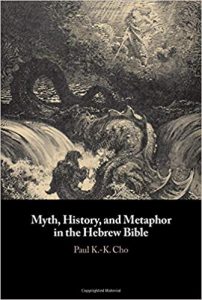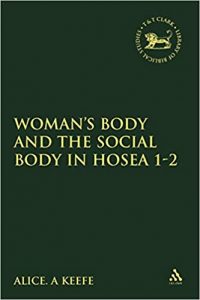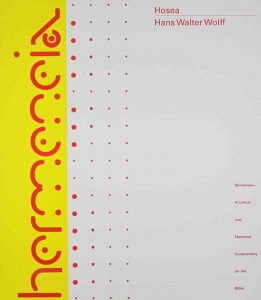Nas p. 355-360 de seu artigo sobre Oseias 4-14, Brad E. Kelle classifica os estudos das metáforas no livro de Oseias, ao longo do século XX e primeira década do século XXI, em quatro categorias. Ele diz:
Overall, developments in the metaphorical study of Hosea can be grouped into four categories: (1) attention to divine and human metaphors; (2) religious, socio-economic, and political interpretations; (3) the indeterminate and unstable nature of the book’s metaphors; and (4) new variations in feminist (and masculinist) approaches to imagery throughout the book.
The first category of metaphor study, which explores the book’s images for God and the people, is the most common, with some emerging engagement with Hosea’s depictions of the natural world and their ecological implications (e.g., Loya 2008). Commentaries from throughout the twentieth century highlight the use of family images (husband–wife, parentchild) as the major depictions of the relationship between God and the people, but also stress the vast array of metaphors used for both God and the people, especially in the oracles in Hosea 4–14 (see Östborn 1956; Wolff 1974; Limburg 1988). These metaphors fall into several clusters, including representations of God with personal imagery (judge, farmer, physician), animal imagery (moth, lion, she-bear), and plant imagery (cypress tree, rottenness), as well as representations of the people with similar animal and agricultural metaphors (stubborn heifer, silly dove, grapes, cake, chaff). The common critical judgment is that no single metaphor holds the key to the entire book, and one cannot use the presence of certain kinds of metaphors (e.g., baking) to reach biographical conclusions about Hosea’s past (Landy 1995b; Eidevall 1996; J.P. Lewis 1997; but cf. Beeby 1989: 3).
(…)
One aspect of Hosea’s metaphors for God that has drawn increasing attention concerns the question of whether certain passages in the book portray God in feminine terms that counter the more prevalent masculine, animal, and royal imagery. The text of ch. 11 in particular has generated a large number of studies on this point, as some feminist interpreters claim that the chapter’s language and imagery depicts Yahweh in feminine terms as a mother who breastfeeds an infant (Schüngel-Straumann 1986; Nissinen 1991; Seifert 1996). The presence of such language, it is argued, can give rise to a feminist theology that offers an alternative to the predominantly patriarchal nature of Hosea’s metaphors, especially as seen in chs. 1–3. Yet some recent studies of the book’s metaphors, including some works produced by feminist scholars,
follow the trend of older commentaries and argue that the language of ch. 11 remains ambiguous, and overtly feminist interpretations rely too heavily on imported assumptions (see Mays 1969: 150; Kreuzer 1989; Eidevall 1996:175; Yee 1996: 277-79; Sweeney 2000: 115).
The second major category of metaphor studies in Hosea scholarship, which offers religious, socio-economic, and political interpretations of the book’s imagery, appears in recent works that try to elucidate the primary underlying issue(s) or rhetorical focus that stands behind Hosea’s discourse (…) The most long-standing interpretation of the book’s metaphors, which has attained nearly unanimous support during various periods of the twentieth century, understands the imagery as addressing a widespread religious conflict in eighthentury Israel between Yahwism and Baalism (…) Several recent works suggest a socio-economic reading of Hosea’s metaphors, based largely upon reconstructions in newer sociological research. These works interpret the prophet’s metaphors as symbols of shifting social and economic relationships among king, cult, priest, and peasantry within Israel’s body politic.
(…)
The third category of metaphor study in Hosea scholarship has garnered less attention in recent years, but builds upon approaches influenced by postmodernist literary perspectives. Since the mid-1990s, a few important studies have stressed the interdeterminacy and instability of the metaphors in Hosea, extending observations about the book’s language in general to the analysis of its metaphors in particular. The characterization by Landy is representative: ‘Metaphorical language, especially in Hosea, is often fractured, baffling, and claims a status verging on madness’ (1995b: 56). From this vantage point, Landy identifies a ‘disintegration’ of metaphors at work in the book, in which the metaphors remain inconsistent and resist coherent integration.
(…)
The fourth category of metaphorical study consists of new variations on feminist approaches to Hosea’s imagery. As noted in the discussion of Israelite religion, some feminist approaches to the book’s metaphorical language published since the 1980s associate Hosea’s female and sexual imagery with traces of goddess worship and other female religious practices that the prophet sought to abolish (Balz-Cochois 1982; Wacker 1996; cf. Adams 2008). More recently, however, Moughtin-Mumby’s comprehensive examination (2008) of Hosea’s sexual and marital metaphors in the context of similar imagery found in Isaiah, Jeremiah, and Ezekiel foregrounds with a new intensity the question of whether the marital metaphor in Hosea 1–3 should establish the meaning for all subsequent sexual and marital imagery in the chapters that follow. In contrast to older studies (Light 1991; J.P. Lewis 1997), Moughtin-Mumby answers in the negative (see also Eidevall 1996), asserting that the diverse types and uses of sexual imagery in Hosea resist any formulation of a ‘standard’ marriage metaphor concept. She argues for a ‘cognitive contextual approach’ that focuses on the specific context and rhetorical function of each use of sexual and marital imagery (2008: 31). Moreover, the other, non-marital and non-sexual metaphors in Hosea, she concludes, provide the wider interpretive frame for the sexual imagery in chs. 4–14 (…) One of the most promising new variations of feminist criticism turns from traditional feminist-critical questions to masculinity studies, exploring the literary, ideological, and theological aspects of masculine imagery for God and people in the book.
Os estudos das metáforas no livro de Oseias podem ser agrupados em quatro categorias:
1. atenção às metáforas divinas e humanas
2. interpretações religiosas, socioeconômicas e políticas
3. a natureza indeterminada e instável das metáforas do livro
4. novas variações nas abordagens feministas de imagens ao longo do livro
1. A primeira categoria de estudo das metáforas, que explora as imagens do livro que falam de Deus e das pessoas, é a mais comum, com algumas abordagens que tratam das representações da natureza e suas implicações ecológicas. Comentários ao longo de todo o século XX destacam o uso de imagens familiares – marido-esposa, pais – como as principais representações da relação entre Deus e o povo, mas também enfatizam a vasta gama de metáforas usadas tanto para Deus quanto para o povo. Essas metáforas se enquadram em vários agrupamentos, incluindo representações de Deus com imagens de atividades humanas, de animais e da natureza, assim como representações do povo com imagens de animais e da agricultura.
(…)
As metáforas do livro de Oseias para falar de Deus são predominantemente masculinas. Mas o capítulo 11 tem provocado grandes debates, pois algumas intérpretes feministas afirmam que a linguagem do capítulo retrata Iahweh em termos femininos, como uma mãe que alimenta uma criança, quando fala de Iahweh que cuida de seu povo. A presença de tal linguagem, argumenta-se, pode dar origem a uma teologia feminista que oferece uma alternativa à natureza predominantemente patriarcal das metáforas de Oseias. No entanto, alguns estudos recentes sobre as metáforas do livro, incluindo algumas obras produzidas por estudiosos feministas, argumentam que a linguagem do capítulo 11 é ambígua, e que as interpretações abertamente feministas têm uma fundamentação frágil.
2. A segunda categoria de estudo das metáforas no livro de Oseias, que oferece interpretações religiosas, socioeconômicas e políticas das imagens do livro, aparece em trabalhos recentes que tentam explicar o contexto do discurso de Oseias (…) A interpretação mais persistente das metáforas do livro, que alcançou apoio quase unânime durante vários períodos do século XX, compreende as imagens como referência a um conflito generalizado entre o javismo e o baalismo no século VIII a.C. (…) Vários trabalhos recentes, entretanto, sugerem uma leitura socioeconômica das metáforas de Oseias, baseada em grande parte nas reconstruções da pesquisa histórica mais recente. Essas obras interpretam as metáforas do profeta como símbolos das mudanças nas relações sociais e econômicas ocorridas em Israel no século VIII a.C.
(…)
3. A natureza indeterminada e instável das metáforas no livro de Oseias constituem a terceira categoria de estudos. Há autores, embora sejam minoria, que percebem a linguagem do livro como fraturada e suas metáforas como desintegradas, refletindo, propositalmene, a situação da época.
(…)
4. A quarta categoria de estudo das metáforas de Oseias traz novas abordagens feministas, postulando que as metáforas matrimonias do livro não devem ser vistas como padrão para a interpretação das outras metáforas, mas sim que cada metáfora deve ser lida no seu contexto e na sua função retórica própria. E há, na primeira década do século XXI, outras variações nas abordagens das metáforas femininas e masculinas de Oseias.
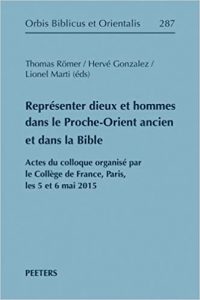 La question des images est centrale pour l’intelligence des religions anciennes et modernes. Cette question est également fondamentale pour comprendre la manière dont un groupe ou une société représente son rapport au monde et la place des humains dans ce monde. Le colloque « Représenter dieux et hommes dans le Proche-Orient ancien et dans la Bible », qui s’est tenu les 5 et 6 mai 2015 au Collège de France, avait pour but d’apporter des éclairages sur ce sujet, en abordant différentes questions qui s’y rapportent:
La question des images est centrale pour l’intelligence des religions anciennes et modernes. Cette question est également fondamentale pour comprendre la manière dont un groupe ou une société représente son rapport au monde et la place des humains dans ce monde. Le colloque « Représenter dieux et hommes dans le Proche-Orient ancien et dans la Bible », qui s’est tenu les 5 et 6 mai 2015 au Collège de France, avait pour but d’apporter des éclairages sur ce sujet, en abordant différentes questions qui s’y rapportent: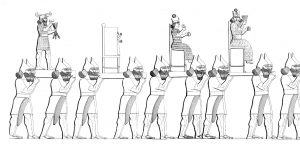 dessas representações? Essas representações fornecem uma melhor compreensão dos cultos oficiais e também dos cultos privados? Qual é o papel das imagens no culto real? É o rei ou todos os humanos que são “a imagem” dos deuses?
dessas representações? Essas representações fornecem uma melhor compreensão dos cultos oficiais e também dos cultos privados? Qual é o papel das imagens no culto real? É o rei ou todos os humanos que são “a imagem” dos deuses?